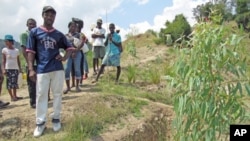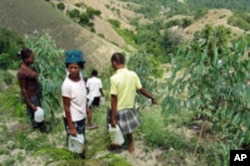Edgar Griffin has lived on this hillside outside the town of Petit Guave for 80 years. He says when he was young, it was lush and green. So green, he says, "You couldn't see a house across from you because it was so green."
Not anymore. Today the mountains are brown and barren. Farmers here try to grow peanuts, but the fertile topsoil washes away in the rain.
"Now, when people plant peanuts, they don't produce as much because the good soil goes into the ocean," says engineer Roudy Valmy with the U.N. International Organization for Migration (IOM).
Clearing land for farming remains the main cause of deforestation worldwide, according to the UN Food and Agriculture Organization. But in Haiti, the loss of tree cover - and the soil erosion that results - has made it much harder for farmers to grow food, worsening the hunger and poverty already gripping the country.
Ninety-eight percent of the country's forests have been cut down, largely to make charcoal - the main cooking fuel in Haiti - where alternatives are unavailable or unaffordable. The same forces drive deforestation in many other developing countries.
Changing attitudes
But villager Emmano Nobert says attitudes here are changing.
"In the past, the old people, they saw the trees, but they did not really know the meaning of a tree to the country," he says. "Today, we, the youth, we are studying, and we know the meaning of a tree to our lives."
Nobert and his neighbors approached the IOM for help restoring these hills. The IOM has several projects in the area giving local people jobs restoring the environment. The IOM's Francois Fournier put Nobert's group to work digging short canals in the contours of the hillsides, to slow down the flow of rainwater and curb erosion.
Fournier says, "In front of each contour canal we plant vetiver," a grass with deep roots to hold the soil in place. "And in back of every row [of canals] we plant trees - over 20 varieties of trees."
"Worth more alive"
Those include fruit-bearing trees like mango, cacao and coffee; and trees that make good building materials that the villagers can sell.
"They're worth more alive than they are as charcoal," says David Delgado with the US Agency for International Development, which funds this project and others.
Delgado notes that trees for charcoal are also planted in order to provide a renewable source of this important cooking fuel.
Results
The project near Petit Guave started just nine months ago, but the results are already plainly visible. From a nearby ridge, this hillside is noticeably greener than those next to it. The grass and trees help the soil retain more water, and Delgado says the villagers are starting to see benefits.
On a recent visit, he says "They pointed down to the bottom of the ravine...and they said, 'You see that tree that's down there? That tree used to never be green this time of year. Since we put in these soil, water catchment programs, that tree has leaves on it.' And more importantly, the water source at the bottom is flowing now year-round."
Longtime resident Edgar Griffin is hopeful about the change in attitude from the old generation to the new.
"It was poverty that made them cut down the trees. Now, we can tell the difference in the soil."
A tale of two hillsides
The trees need care in the first two years after planting to help them get established. The IOM does not pay villagers for this work. The IOM's Francois Fournier says the volunteer work is intended to help the community feel ownership of the project.
On a recent afternoon, Griffin's community was out watering and weeding the young trees, singing while they worked in the hot sun.
But other nearby communities do not share this enthusiasm. At a similar project nearby, villagers had stopped watering and weeding young trees months ago. The trees were much smaller and many had died. The hillside was much browner than Griffin's.
"It's better than it was, for sure," Fournier says. "But it was supposed to be two or three times better in the quantity of trees. I'm disappointed. What can I say?"
Fournier says he will not be pursuing any more projects with this community.
Experts say creating jobs replanting trees could make a significant difference across Haiti, where both deforestation and unemployment are rampant. In the wake of Haiti's devastating earthquake and the country's chronic hunger problems, the government and international donors are considering planting trees as a way to help workers, farmers and the environment all at the same time.
















